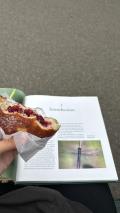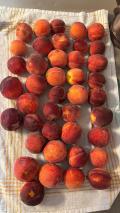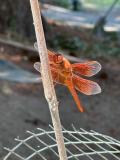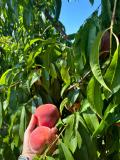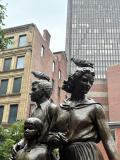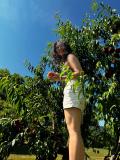Monday, July 8, 2024
By:
This is a blog post, so I am here to push the dragonfly agenda, once again. They are, after all, the love of my life. However, I’ll introduce this week with bees. The Bee Movie begins with lies about bees (it also makes no sense in almost every single way, but that’s not what we’re here for). They say that according to the laws of aviation, bees should not be able to fly. We have all seen bees. We all know this is false. So then–how do bees fly?
Flying insects don’t follow the same aerodynamic laws as airplanes. Many years ago, some researchers (in the paper Flow visualisation and unsteady aerodynamics in the flight of the hawkmoth, Manduca sexta) visualised how air moved around insects. They put moths in a wind tunnel and filled it with smoke to observe how the moths’ wings changed the flow of the air around them. This was fluid dynamics research, looking at how liquids and gases move and interact with things. They discovered something we now call leading-edge vortices.
The airflow on top of an insect wing does not flow smoothly around it like it would around the wing of an airplane. Instead, we see that the air moves into a circle on top of the wing. The air inside this circle rotates, creating a vortex. Specifically, this is a leading-edge vortex. In the middle of the vortex, airflow is rotating very fast, creating an area of low pressure at the top of the wing. The area under the wing is comparatively high-pressure. This means the pressure on the lower surface of the wing pushes up harder than the pressure on the upper surface pushes down. This imbalance of forces lifts off the wing, allowing the insect to fly.
In dragonflies, we don’t just see fluid dynamics in studying how oscillating wings interact with the surrounding air, but also because of how the wings interact with each other. Because dragonflies have four wings, airflow over the back wings is influenced by how the front wings move the air around them. This is especially influenced by the phase difference in the flapping of the wings – whether or not they beat up and down in-phase or out-of-phase. The current theory is that the back wings expect the leading edge vortex the front wings create. When the front wings flap, they leave that vortex or wake, behind in the air. When the front and back wings are out-of-phase, the back wings rotate in a certain way to intersect and capture the wake. This happens most efficiently at a phase difference of 90 degrees. This phenomenon, called ‘wake capture’ or ‘wing–wake interaction’, lets the back wings capture the wasted energy from the front wings and gives the insect extra lift. This allows dragonflies to have extremely efficient flight. However, the wings need to be at that correct phase difference for it to occur. We know about phase differences in dragonfly wings! I wrote all about them in week 2.
Once again, vortices were not what I worked on this week. On Monday, I took the train back from New York and did some prep work for AAPT. I finished up the research on STEM schools and worked on my presentation for the AAPT Summer Meeting. On Tuesday, I went to ACP DC and wrote this year’s SPS Physics Jeopardy. Many thanks to Sonja for some fantastic categories. I think my favourites are ‘First Names of People There are Equations Named After’ (Who even is Coulomb?), ‘Fun Facts About Physicists Unrelated to Physics’ (Do you know about Einstein’s opinions on clothing?) and ‘Name that Unit!’ (I give you SI base units, you tell me what fun unit it is). Also, we went to trivia! Wednesday, I experienced trials and tribulations. The University of Maryland is conducting construction from hell near ACP at College Park. I did not know this. As a result, I walked down my regular path to the office, only to have to turn around and find another way in. I got lost, sweat so very much, and ranted about pedestrian-unfriendly roads to my family (who I called on my walk). I eventually reached the office, where Mikayla and I gathered basement materials for the SOCK and then ordered the rest of our items. Rianna (much love) gave me a ride to the station on the way home.
Very minimal work and very many other things got done on Thursday and Friday. Thursday morning, Kai and I went to a bakery and sampled a variety of delicious treats (curry butternut squash tart is 10/10). We took a brief indoor break at Shenkman and then headed to Jaden’s frat for a barbeque. We ate hot dogs, ate some more hot dogs, and counted how many people walking past were wearing matching outfits with Jenna. After another quick indoor break, we camped out at the National Mall for the fireworks. Kai was attacked by gnats. I cried at the birds being scared of the fireworks. A fantastic time for this pair of roommates. Friday, this pair of roommates had the grand idea to go peach picking! We drove to Virginia and came home many hours later with 50 peaches (+10 eaten at the farm), a quart of blueberries, a quart of blackberries, 2 peach slushies (consumed), 3 jars (for peach compote), and stomachs full of Shenandoah berries (all compound berries in the Northeast are edible (especially wineberries (they are invasive. Eat them))). It was a fantastic day.
Saturday, I woke up bright (dark) and early for a 7 am flight to Boston for AAPT. I arrived, dropped my items off at the hotel, and spent the day walking around the city. Acquisitions: a bowl of chowder, coffee, a (very) jammy doughnut, a dragonfly book, a song sung about me by a man in the park, takeout lu rou fan. Sights: four bookstores, statues wearing pigeon hats, a priestly clothing store, all of Boston’s old streets, a historically accurate man using a printing press to print copies of the Declaration of Independence, and many ducks. Sunday, I went to a workshop called Maximising Learning and Engagement with Demonstrations (where I got some fantastic SOCK advice and ideas), hung out with my college friend (also here for the conference), and went to multiple welcome receptions (I met the board of AAPT? AND got a picture with Jocelyn Bell Burnell (I was starstruck). Crazy stuff). More AAPT to come this week!
This week’s dragonfly is Libellula saturata, the flame skimmer (or firecracker skimmer). It is a species native to western North America and the male dragonflies are bright red and orange. My friend sent me a picture of one this week. It’s awesome.
Maia Chandler


